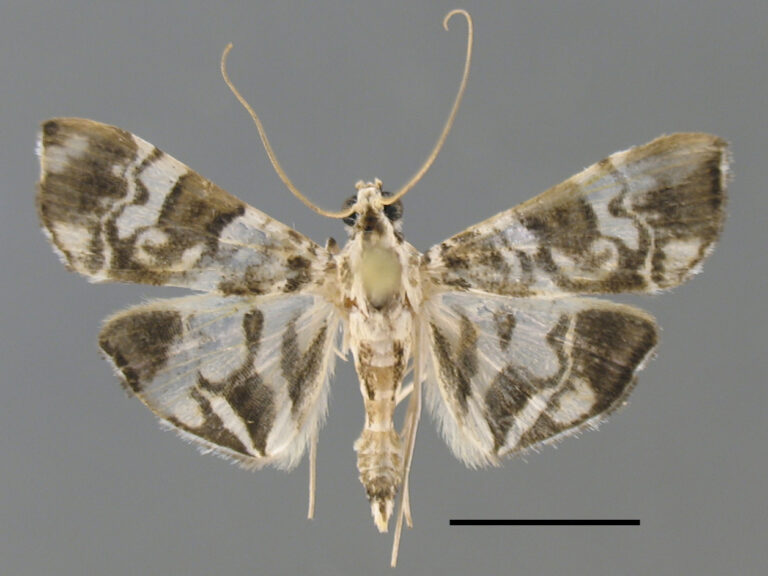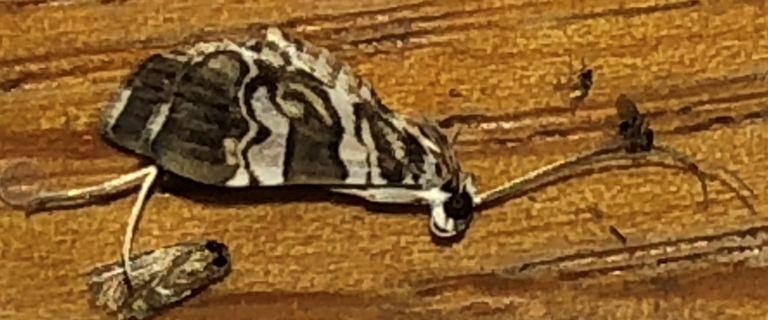
Chabula acamasalis (Walker, 1859) (Lepidoptera: Crambidae) is native to India, East Asia, and northern Australia (Shaffer et al. 1996; Singh et al. 2022; GBIF.org 2023). It has recently appeared in the State of Florida, United States; specimens were observed in 2020 (1, Davie, Broward County) and 2022-2023 (1, Vero Beach, Indian River County and 2, Ft. Lauderdale, Broward County) (Nanz 2020). All specimens were photographed, but only those from Ft. Lauderdale were collected (Fig. 1) (Hayden 2022). A fifth specimen was collected in Monroe County in a carbon dioxide-baited miniature light trap during routine surveillance for mosquitoes.
A single female Chabula acamasalis was collected on 7 November 2023 on Angelfish Key, Monroe County, Florida, USA, in the trap at a residence (Fig. 2). Angelfish Key is located off the northern tip of Key Largo and is part of the Ocean Reef Club development. The islands of Biscayne National Park lie just across the channel to the north. The specimen was deposited in the Florida State Collection of Arthropods (FDACS-DPI sample # E6371-01-11272023-12020). Specimen data are available through the Florida Museum of Natural History's online database (Florida Museum Lepidoptera Collection 2023; Catalog #13853).
Chabula acamasalis can be unambiguously identified by wing pattern; the distal broad white band of the forewing is B-shaped and meets the costa broadly, and the tornus of the forewing has a white patch (Inoue 1982). Adults are known pollinators of Cucurbitaceae (Barman et al. 2023). Larvae have been found feeding on tree roots (probably Brachychiton sp. or Ficus sp.) in Australia (Howarth 1988) and on aerial roots of Ficus microcarpa L.f. in Hong Kong, China (Ritafoo 2023). It has now been recorded from the following Florida counties: Broward, Indian River, and Monroe. Although the moth was previously collected from the mainland of Florida, this record is the first from the Florida Keys. The distance between the sightings of this moth raises questions about its dispersal. Are these geographically separate records distinct introductions or secondary dispersal from a single initial event? There are no other known records from the Americas. How is this moth moving from one site to another? One interesting possibility is human transfer of host plant material. For over a century it has been recognized that moving plants often means also moving insects, e.g., Lowe (1897). Simonsen et al. (2008) studied the dispersal of the cactus moth, Cactoblastis cactorum (Berg), in the United States and determined that the moth had been introduced to the USA at least twice, and that human transport of host plants was the likely mechanism for dispersal. Both Brachychiton sp. and Ficus spp. trees are used in landscaping in Florida (Anonymous 2020; Brown undated). The trap site is directly adjacent to two banyan trees, Ficus (Urostigma) sp., raising the possibility that the moth was attracted to the trees rather than the trap.
We thank Florida Mosquito Control District trapping technician Alana Loftus for setting and retrieving the trap. We also thank Barbara Center for finding the first specimen in Ft. Lauderdale. This publication was supported by the Florida Department of Agriculture – Division of Plant Industry.
Anonymous. 2020. Brachychiton acerifolius, Flame Bottletree. UF/IFAS. Accessed 2024-01-20: https://hort.ifas.ufl.edu/woody/ Pages/braace/braace.shtml
Barman, M., R. Tenhaken, and S. Dötterl. 2023. A review on floral scents and pigments in cucurbits: Their biosynthesis and role in flower visitor interactions. Scientia Horticulturae 322: 112402. https://doi.org/10.1016/j.scienta.2023.112402
Brown, S.H. Undated. Ficus: Trees and Vine of Florida. UF/IFAS. Accessed 2024-01-20: PDF
Florida Museum Lepidoptera Collection. 2023. FLMNH Lepidoptera Specify Web Portal. Hosted by the Florida Museum of Natural History, Gainesville. Accessed 2024-01-20: http://specifyportal.flmnh.ufl.edu/leps/
GBIF.org. [Global Biodiversity Information Facility] 2023. GBIF Occurrence Download. Accessed 2024-01-20: https://doi.org/10.15468/dl.k2pu55
Hayden, J.E. 2022. Chabula acamasalis (Walker), a crambid moth, a new Continental USA record. Tri-ology 61(4): 7. PDF
Howarth, F.G. 1988. Environmental ecology of North Queensland caves: or why are there so many troglobites in Australia. Pp. 76-84 in: Australian Speleological Federation 17th Biennial Conference preprints, Lake Tinaroo, December 1988.
Inoue, H. 1982. Pyralidae. In: Inoue, H., S. Sugi, H. Kuroko, S. Moriuti & A. Kawabe. Moths of Japan Vol. 2: 223–254; pls. 36–48, 228, 296–314. Kodansha, Tokyo. (Plate 39, fig. 24.)
Lowe, V.H. 1897. Inspection of nurseries and treatment of infested nursery stock. New York Agricultural Experiment Station Bulletin No. 136. https://hdl.handle.net/2027/uiug.30112019756938
Nanz, S. 2020. Species Chabula acamasalis. BugGuide, hosted by Iowa State University. Accessed 2024-01-20: https://bugguide.net/node/view/1802566
Ritafoo. 2023. iNaturalist observation. Accessed 2024-01-20: https://www.inaturalist.org/observations/189564963
Shaffer, M., E.S. Nielsen, and M. Horak. 1996. Pyraloidea. Pp. 164–199 In: Nielsen, E.S., E.D. Edwards, T. V. Rangsi (eds.). Checklist of the Lepidoptera of Australia. Monographs on Australian Lepidoptera 4. CSIRO Division of Entomology, Canberra.
Singh, N., R. Ranjan, A. Talukdar, R. Joshi, J.S. Kirti, K. Chandra, and R. Mally. 2022. A catalogue of Indian Pyraloidea (Lepidoptera). Zootaxa 5197 (1): 1–423. https://doi.org/10.11646/zootaxa.5197.1
Simonsen, T. J., R. L. Brown, and F.A.H. Sperling. 2008. Tracing an invasion: phylogeography of Cactoblastis cactorum (Lepidoptera: Pyralidae) in the United States based on mitochondrial DNA. Annals of the Entomological Society of America 101: 899-905. https://doi.org/10.1603/0013-8746(2008)101[899:TAIPOC]2.0.CO;2
Walker, F. 1859. List of the Specimens of Lepidopterous Insects in the Collection of the British Museum. Part XIX – Pyralides. Edward Newman, London. https://www.biodiversitylibrary.org/page/38886233

Figure 1: Male Chabula acamasalis, Fort Lauderdale, FL, September 2022, Ted and Barbara Center. MGCL Catalog #4. Scale bar = 5 mm.

Figure 2: Female Chabula acamasalis, Angelfish Key, FL, December 2023, A. Loftus leg. MGCL 13853.